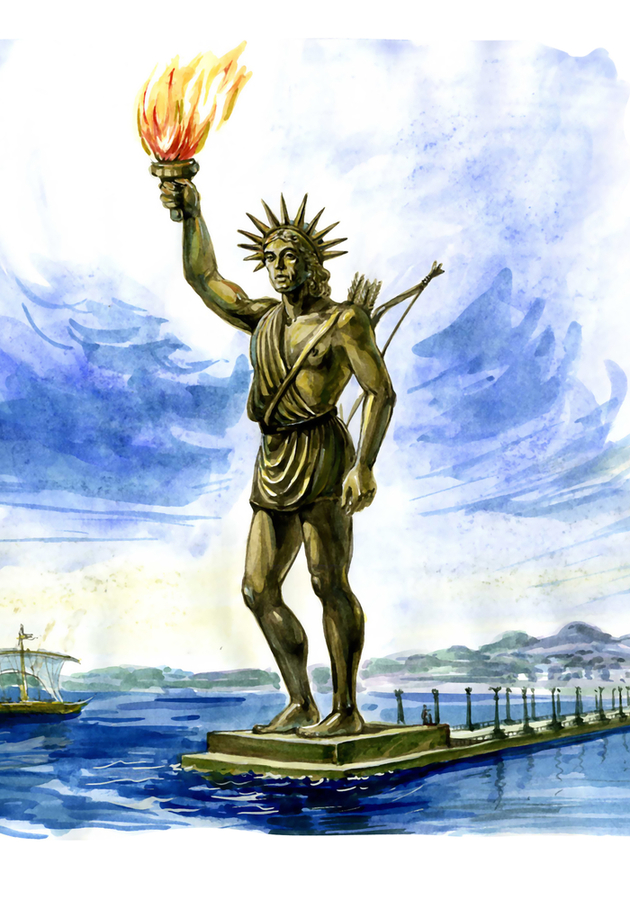In his “Natural History,” published in AD 77, Roman encyclopedist Pliny the Elder describes the Colossus of Rhodes, the ancient forerunner of the Statue of Liberty, as “by far the most worthy monument of human admiration.” “Few men can clasp the thumb in their arms,” he writes, “and its fingers are larger than most statues. Where the limbs are broken asunder, vast caverns can be seen yawning in the interior.” In Pliny’s time, as is obvious from the quote, the Colossus was merely a ruin, slowly corroding where it had fallen more than a century before, toppled by an earthquake around 225 BC. Yet, that didn’t diminish Pliny’s awe.
How could it have? A gigantic bronze thank-offering to the sun god Helios, the Colossus of Rhodes was easily the largest statue of antiquity; even as a ruin, it must have been astounding. We know why it was built, and even who was the ingenious artist who conceived it, but everything else about it remains an inspiring mystery. No copies were ever made of the Colossus and there are no eyewitness accounts to tell us what it looked like when it still stood. Nevertheless, for about half a century after it had been erected in 280 BC, it did stand somewhere along the harbor entrance to the island of Rhodes, glistening in the sun, towering over the buildings of a mighty city-state. Let’s pay it a visit.
The city of Rhodes
Rhodes, the largest of the Dodecanese islands, is located northeast of Crete, southeast of Athens and about 10 miles (16 km) off the southwestern corner of the Anatolian mainland; as such, it lies at a crossroads between Europe, the Middle East, and Africa. In antiquity, two major sea routes passed through the island: between Egypt and Libya to the south and the Ionian trading towns along the Anatolian coast to its north; and between mainland Greece to the west and Cyprus and the Levant to the east. Rhodes was thus always a cosmopolitan island, an island of many different identities and cultures. It was Greek enough to look classical in the ornate Middle East, but too far off the Greek mainland to not be receptive of non-Greek influence from the north of Africa or the interior of Asia Minor. As a result – and to say the least – Rhodes’ relations with mainland Greece were always ambiguous.
At the beginning of the 5th century BC, the Persians invaded the island, but in 478 BC, they were defeated by forces from Athens. Henceforth, Rhodes became part of the Athenian league, an association of Greek city-states under the leadership of Athens. Nevertheless, when the Peloponnesian War between Athens and Sparta broke out in 431 BC, Rhodes chose to remain largely neutral. Sometime later, at the urging of Carian ruler Mausolus, the Rhodians withdrew from the Athenian-led confederacy altogether, deciding to go their own way. Indeed, they did. In the course of Alexander’s fight against the Persians, they sided with their former Asian invaders. They switched sides only after it became obvious that Alexander was getting the better of the Persians. In a final twist, after the dissolution of Alexander’s empire, Rhodes formed an alliance with Ptolemy, who based his power in Egypt, rather than with Antigonus who inherited mainland Greece.
In 409 BC, the island’s three main cities (Ialyssos, Kamiros and Lindos) united to form one territory, the city of Rhodes. In the wake of Alexander’s death, owing to its ideal geographic location, Rhodes became the leading maritime city of the Greek world. Housing more than 200,000 inhabitants, it was an enormous place, home to three times as many people as it is today. In the true spirit of Hellenism, it was a cosmopolitan city, ambitious and hedonistic: it was said of the Rhodians that they ate as if they were going to die soon and built as if they were going to live forever. Indeed, the two most celebrated statues of the Hellenistic Age – the Laocoon group and the Winged Victory of Samothrace – were carved by Rhodian sculptors. The Colossus, however, was always the island’s most famous piece of statuary. It owed its construction to a momentous siege.
The siege of Rhodes
Following the death of Alexander the Great, his generals vied for control of his vast empire, sparking the notorious War of the Diadochi. Three of them eventually succeeded in dividing the empire amongst themselves: Ptolemy became ruler of Egypt, Seleucus of Persia, and Antigonus of the Greek mainland. Even though essentially neutral, the city of Rhodes sided with Ptolemy, seemingly for commercial considerations. Antigonus’ son, Demetrius I – infamous among his enemies as Poliorcetes or “The Besieger of Cities” – was worried that the thriving and wealthy city of Rhodes would supply Ptolemy with ships and weapons which would allow further expansion of his rival’s kingdom. Furthermore, he feared that Ptolemy might use the island as a base of operations. Swayed by these fears, Demetrius decided to lay siege to Rhodes and force the commercial and cultural hub into submission.
In 305 B.C., 70,000 Macedonians descended on Rhodes. Along with a fighting fleet of 200 ships and 150 auxiliary vessels, Demetrius Poliorcetes also enlisted the aid of hundreds of pirate flotillas, each of which was promised part of the plunder after the conquest; yet another proof of how wealthy Rhodes was at the time. Fortunately for the Rhodians, it was also strongly fortified. Unable to capture the main harbor during the first attack, Demetrius ordered the construction of a huge and sophisticated siege tower, called the Helepolis, “The Taker of Cities.” The largest siege tower of antiquity, the Helepolis was 130 feet (40 m) high and about 65 feet (20 m) wide, and had to be manned by no less than 200 soldiers. Divided into nine stories, it housed a fearsome complement of heavy armaments, as various types of catapults and ballistae were placed at each of its different levels.
Yet, even the Helepolis was no match for the ingenuity of Rhodian builders. The night before Demetrius’ attack, Diognetus the town architect, ordered the islanders to knock a hole through the city walls opposite to the siege tower. Then he instructed them to throw, on the other side of the hole, all the water, filth, and mud they could obtain. And so, the following day, when the Helepolis was advanced toward the wall, it sank in the quagmire thus created. Demetrius had no choice but to draw off his army and lift the siege in 304 BC, leaving behind not only a free Rhodes, but also a marvelous siege tower. The Rhodians melted down its metal plating and sold the rest of it, using the materials and the money to erect an enormous thank-offering statue to the sun god Helios, their patron deity. The ancients, nevertheless, were so astounded by its grandeur they preferred a different name for it: the Colossus.
The look of the Colossus
The Colossus was probably made between the mid-290s BC and 280 BC. Most sources agree that when it was finished, it stood about 110 feet (33 m) tall, which makes it about the same height as Nelson’s Column in Trafalgar Square or the Statue of Liberty in New York Harbor, if measured from heel to top of head. There was no precedent for a similar sculptural feat anywhere in the ancient world. In fact, it was its enormous size that gave the world the word ‘colossus’ in its familiar meaning. Pre-Greek, this word had previously been used quite chaotically, of statues both big and small, sometimes even as a synonym for monument. The Rhodian Helios, once and for all, fixed its use for immensity and grandeur. Indeed, the Statue of Liberty was referred to as “the New Colossus” for long through the 20th century; moreover, its dedicatory verses come from an Emma Lazarus poem which bears the same title.
Little more is known for certain about either the appearance or location of the Colossus. The best guess is that it was a naked statue of the Sun God, lifting a torch in one hand and holding a spear at his side in the other. An Italian visitor of Rhodes in 1395 related, for curious travelers, a local tradition which claimed that the Colossus (who was, by that time, nothing more than scraps of metal) once straddled the harbor mouth of the island. Even though this striking image has survived to this day – popularized by numerous artistic renditions and a few Hollywood movies – it is surely nothing more than a medieval misapprehension. For such a tall statue to withstand the forces of wind and weather, it had to be columnar in shape, with legs close together, and arms either held by the sides or raised directly above. Any other pose would have rendered the statue quite unstable.
Fortunately, thanks to a 4th-century Rhodian coin depicting the Sun God, we do have some idea of what the head of the Colossus looked like. Almost certainly – and much like the Statue of Liberty – it was crowned by an aureole (Oriole) of pointed flames and loose, curled locks of hair as if blown by the wind. The face was realistic, almost cherubic, with lips slightly parted, and eyes squinted against the sun. A bas-relief from a Rhodian temple shows Helios shading his eyes with his right hand; it is possible that the Colossus was done in that same pose as well, rather than with a flaming torch. The latter, though, is somewhat more probable because the dedicatory inscription of the statue explicitly mentions a torch. Amazingly, the poem has survived to this day, preserved in an ancient Greek anthology. “To you, Helios,” it says, “yes, to you the people of Dorian Rhodes raise this Colossus high up to the Heavens, after calming the bronze wave of war, and crowning their country with spoils won from the enemy. Not only over the sea but also on land they set up the bright torch of unfettered freedom.”
How the Colossus was built
The main reason why the Colossus of Rhodes made it to the original list of Seven Wonders was neither its look nor its ornaments. Even the most generous and idealistic amongst modern archeologists agree that the statue must have had a rather rigid pose, exhibiting nothing of the sumptuous baroque that made Rhodian sculptures so renowned throughout the Mediterranean over the Hellenistic Age. However, the very achievement of casting a gigantic bronze figure made the Colossus an immediate symbol of technological ingenuity and engineering prowess. Truth be told, to this very day, we still don’t know how the Colossus was actually built. We do know that the commission to make it was given to a renowned local sculptor named Chares of Lindos and that he worked on the statue with a group of devoted bronze-casters for no less than a dozen years. Anything other than that remains in the realm of pure speculation.
Nevertheless, if we are to believe the ancient Greek writer of the little travel guidebook “The Seven Sights of the Ancient World” (who, quite dubiously, identified himself with the Alexandrian engineer Philo of Byzantium who lived in the 2nd century BC), then we must suppose that the Colossus was cast in situ, that is to say, in its original place. Indeed, its sheer size would have made it impossible for ancient draftsmen to cast limbs and body in separate parts and then fix them together. Instead, Philo tells us, they built the Colossus in sections, pretty much upon itself. When the feet were set in a position on a marble base, mounds of earth were piled around them to serve as a platform from which the artisans could move up to construct the next part. This went on for years. To stabilize the structure, Chares fortified the bronze from within by iron tie bars and giant blocks of stone. For Philo, the technological complexity of the interior was even more magnificent than the outside form of the Colossus.
Possibly the greatest skill of the endeavor lay in the fact that neither the artisans nor Chares could see what the statue looked like until the very last part was cast and set in place, since only then the mound of earth could be finally removed. “The great artist,” explains Philo, “had to preserve the shape of the work in his mind for, as parts of the Colossus were finished, he poured a huge quantity of earth about the base hiding that part already completed, so that he might finish the next parts from ground level. He gradually ascended to the very topmost point of his desire, making a godlike image from 13 tons of bronze and 7 tons of iron, and so freeing a great work of art from the bold mind of its creator. When that happened, the world got a lot brighter, for Chares managed to add a second Sun to stand face to face with the first.”
The fallen Colossus
The only problem with Philo’s explanation is that modern commentators have deemed the casting-on of new hot bronze onto cold bronze already cast pretty much impossible. Hence, some of them have concluded that the process must have been a bit simpler, encompassing the gradual fitting of bronze plates to a stone-weighted iron armature. “Perhaps,” writes a contemporary archeologist, “the plates were indeed molded onto this armature on the spot, but certainly not seamlessly cast onto any already set bronze outer surfaces.” Either way, even for a wealthy city-state such as Rhodes, obtaining the necessary quantities of bronze for the Colossus must have been a difficult affair, which is why the statue probably rose about 6-8 feet (2-2.5 m) per year. Another reason was certainly the sheer time it would have taken the Rhodians to melt and cast the bronze parts, and then construct and raise the earthen mound around it.
The last of the Seven Wonders to be built, the Colossus was also the first one to be destroyed. For all the awe it inspired in onlookers, it stood erect for little more than half a century. A powerful earthquake hit Rhodes around 225 B.C., ruining most of the city and breaking the statue at its weakest point – the knees. All three of the successor states of Alexander’s empire rallied around to help the island. Ptolemy III of Egypt, known also as Ptolemy the Benefactor, offered to cover all restoration costs for the toppled monument. However, in accordance with a certain oracle which forbade them to rebuild the statue, the Rhodians refused to raise the Colossus again. “And so,” writes historian Paul Jordan, “after a very short career in its intended form, the Colossus became a wonder for what it must have been rather more than for what it now was, however much the broken pieces might still impress and arouse curiosity as to the statue’s method of construction.”
The Colossus lay where it fell for nearly nine hundred years. In 653, Mu’awiyah I, the brother-in-law of the prophet Muhammad and the founder of the fearsome Umayyad Caliphate, sent his naval forces to a full-scale invasion of Rhodes. In its aftermath, the Arabs looted the once-famous city-state and carried off the wreckage of the Colossus back to Asia Minor. We must suppose that it wasn’t at all difficult to break up the statue at the time, considering the fact that it was already severely bruised by a millennium worth of elemental forces and that it had been cast in separate pieces in the first place. We don’t know what happened to the Colossus afterward. Some sources say that Mu’awiyah sold all of the remains as scrap metal to a Jewish merchant from Emesa, who then conveyed them into Syria on no less than 900 camels. Behind their footprints, all traces of this once-magnificent statue vanished into silence – and oblivion.
Sources
Main
- Paul Jordan, Seven Wonders of the Ancient World (Routledge, 2002).
- Christopher Scarre, ed. The Seventy Wonders of the Ancient World (Thames & Hudson, 1999).
- John Mck. Camp II, “Colossus of Rhodes,” An Encyclopedia of the History of Classical Archaeology [Nancy Thomson de Grummond, ed.] (Greenwood Press, 1996), Vol. I, pp. 314-5.
Ancient
- Anthologia Graeca vi.171. [https://archive.org/details/greekanthology01pato/page/386/mode/2up]
- Diodorus Siculus, Bibliotheca historica, xx.48. [https://penelope.uchicago.edu/Thayer/E/Roman/Texts/Diodorus_Siculus/20C*.html#48]
- Philo of Byzantium, “On the Seven Wonders of the World,” RogerPearse.com [Translation and notes by Roger Pearse] (August 23, 2019). [https://www.roger-pearse.com/weblog/2019/08/23/philo-of-byzantium-on-the-seven-wonders-of-the-world-an-english-translation-and-some-notes/]
- Pliny, Natural History xxxiv.18.41. [https://www.perseus.tufts.edu/hopper/text?doc=Perseus%3Atext%3A1999.02.0137%3Abook%3D34%3Achapter%3D18]
- Strabo, Geographica xiv.2.5. [https://penelope.uchicago.edu/Thayer/E/Roman/Texts/Strabo/14B*.html]
- Vitruvius, De architectura, x.16.3-8. [https://penelope.uchicago.edu/Thayer/e/roman/texts/vitruvius/10*.html]
Other
Peter D’Epiro & Mary Desmond Pinkowish, What Are the Seven Wonders of the World?: And 100 Other Great Cultural Lists (Anchor, 1998), pp. 179-187.
John Leonard, “The Colossus of Rhodes,” Greece Is (August 11, 2017) [https://www.greece-is.com/the-mystery-of-the-colossus-of-rhodes/]
Mark Cartwright, “Colossus of Rhodes,” World History Encyclopedia (July 25, 2018) [https://www.worldhistory.org/Colossus_of_Rhodes/]





























